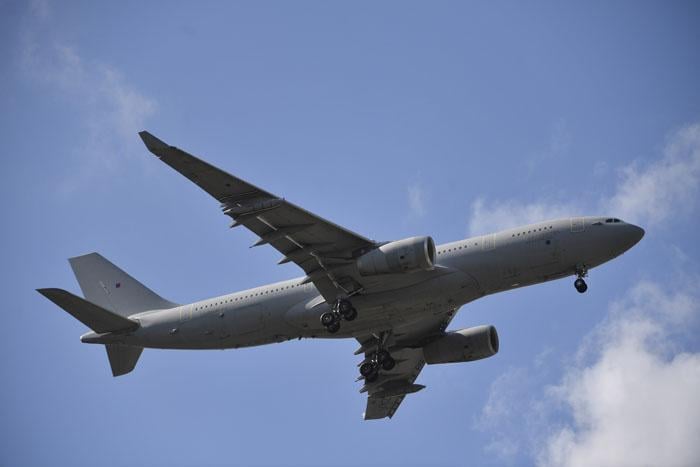
Airbus is preparing to launch of new variant of the A330 MRTT, pictured here performing a flyby at Farnborough Airshow.
FARNBOROUGH—Airbus expects to deliver the first of its A330neo-based aerial refueling tankers before the end of the decade, a development that should extend the multirole tanker transport’s (MRTT) range advantage over the rival Boeing KC-46.
Airbus is studying how to turn the A330-800 into the replacement for the A330-200-based tanker that it has been selling for more than a decade. With the older A330 out of production for commercial customers, Airbus has to effectively make the switch to the new platform. But speaking at the Farnborough Airshow here, Jean-Brice Dumont, head of airpower at Airbus Defense and Space, also says the evolution is an upgrade “to meet a market demand.”
Airbus has been in a derisking phase to ensure platform changes—including in air flow, because of wing and engine changes—will not upset the system’s ability to do the job. Learnings from that effort have provided “a high level of confidence” that the A330neo could be used in the tanker role, program boss Maria Angeles Marti says.
Airbus sees demand for around 161 tankers through 2033. The bulk of that demand is in the U.S., a defense market that the European plane maker has struggled to penetrate. The Asia-Pacific, Middle East and Europe are the largest markets, Dumont adds, equal to about the size of the U.S. market. “There is a significant market ahead of us.”
“We have customers interested and we have customers in a hurry,” Dumont says of the MRTT+ upgrade program. MRTT+ will be launched with a customer, Dumont says, with customers looking for the system before the end of the decade. The development period should last for roughly four years, he indicates.
Airbus Defense & Space chief Michael Schoellhorn said the go-ahead for the MRTT+ program could come this year.
Airbus, which initially won a U.S. Air Force tanker competition teamed with Northrop Grumman, eventually lost the deal in a rerun of the competition to Boeing, which has since lost billions of dollars on the program. The Air Force continues to evaluate paths for buying more tankers. Airbus, which is waiting to see what that solicitation looks like, has not yet said what its bidding strategy may be.
“It is obvious you go to the U.S. with U.S. partners,” Dumont says. But he suggests no teaming agreements have been finalized yet.
Airbus says wing improvements and more efficient engines will boost the MRTT+ range to 2,160 nm from 2,000 nm, increasing its range lead over the rival Boeing KC-46, which Airbus says offers a range of 1,500 nm. Customers can also trade the greater range for more fuel-offloading capacity, Marti says.
Boeing has countered that the KC-46’s smaller size makes it a better fit for many military bases.
Airbus is also working on other tanker upgrades, with an eye on improving the MRTTs already delivered to customers. One key enhancement the company is already introducing is the ability to automate refueling using the boom. The company has validated daytime operations with its Singaporean customer. It has since conducted tests in recent weeks involving more than 500 refueling contacts at night that should enable it to get certification for nighttime operations early next year, Marti says.
The company is also exploring the ability to turn the tanker into a battlefield communications node and enhance its self-protection suite to make it more survivable.





